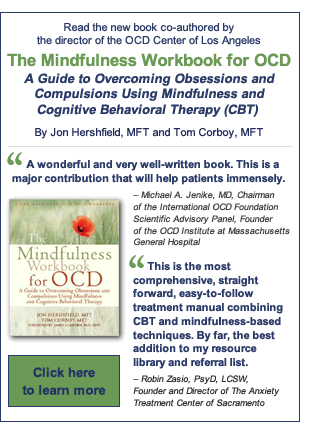The “Stockholm Syndrome” is a term used to describe the phenomenon of hostages defending their captors. As a psychotherapist specializing in Cognitive Behavioral Therapy (CBT) for the treatment of Obsessive Compulsive Disorder (OCD), I have seen something akin to the Stockholm Syndrome many times. Clients struggling with this issue often have a mysterious internal debate that goes something like this:
“If I hate OCD so much, why do I fight so hard to keep it around? Maybe my OCD is a good thing. Maybe I need my OCD. After all, If I am not my OCD, then who am I?”
This scenario typically (although not always) presents itself several months into therapy, long after the client has gained some autonomy from their OCD through the use of Cognitive Behavioral Therapy.
Cognitive Behavioral Therapy and the OCD Stockholm Syndrome
Effective treatment for OCD focuses primarily on two Cognitive Behavioral Therapy techniques. The primary cognitive technique used in treating OCD is Cognitive Restructuring. This technique works by teaching you how to recognize the distorted thinking that builds layers of obsessive fear around you. The primary behavioral technique used in treating OCD is Exposure and Response Prevention (ERP). This technique works by peeling off the layers of fear and exposing your mind to freedom from compulsions. Combined, these CBT techniques are the gold standard for the treatment of OCD and related anxiety disorders.
“But what if the layers of fear are peeled off only to reveal nothing inside? What if I’m an empty shell?”
Ironically, the appearance of this new fear is often actually a sign that CBT is working. Since the first time you touched that doorknob and resisted washing or sat alone with a defenseless child while imagining the unimaginable, you’ve had your OCD on the run. Always looking for its next in, the OCD starts grasping at straws. The final straw, it claims, is that you need your OCD to be who you are. This is certainly among OCD’s more cynical traps.
While virtually all clients recognize that life without countless, misery-inducing rituals is better, some people with OCD actually start to advocate for keeping some of their compulsions. The thinking appears to be that some compulsions are worth hanging on to, and it becomes important for the sufferer to defend them. The therapist becomes the bull in the brain’s delicate china shop, destroying a carefully constructed self-preservation system. This opens the door for OCD to attack the one weapon essential for successful treatment: a client’s motivation.
One client often struggles with capturing the motivation to do his ERP homework assignments. Sometimes the ERP assignments are not as terrifying as he had anticipated they would be and this causes a new problem. Here is what his OCD exclaims:
“See…this is too easy! You can do it and your so called OCD will be gone before you know it. Your therapist will send you off as soon as he figures out your OCD is really not that bad, and before you feel ready. He has lots of other clients who are probably way worse than you and you would be selfish to ask for any more of his time. And when he kicks you out, you’ll be lost and confused and wonder whether it was all a lie, and you’ll feel terrible for ever having presumed that your problems were any different than anyone else’s problems or that your problems were bad enough for you to seek special treatment when there are so many out there who have it way worse than you.”
The reason we so often lose at playing the OCD game is that it cheats. We play fair. We use logic. But OCD comes to the knife fight with automatic weapons. It is willing to go so far as to deny its own existence in order to preserve that same existence.

Well, I have good news and bad news. The bad news is you will have unwanted intrusive thoughts (everybody does), and somewhat unusual strategies for coping with them, for the rest of your life. The good news is that, if you accept those thoughts, they need not be so problematic. Unwanted thoughts happen. What they mean about you is just an ongoing debate between you and your OCD. But the effect they have on your functioning is the difference between having a disorder and just being you.
Mastering The OCD Stockholm Syndrome
As with any OCD fear, the way to master the OCD Stockholm Syndrome is to habituate to it using ERP, being vigilantly compliant with therapy, and risking suddenly finding yourself without OCD. This entails tolerating uncertain thoughts of being a fraud or a deceiver of the mental health system. And it may mean you temporarily feel like you don’t deserve treatment because you don’t really suffer as much as you think you should.
On a cognitive level, mastering the OCD Stockholm Syndrome means engaging in your ERP homework without first capturing that “feeling” which makes you believe you are motivated to do the work. In other words, change the behavior first, and then wait patiently for your thoughts and feelings to catch up.
The processing error that allows OCD Stockholm Syndrome to take shape involves a distorted belief that, in the future, you will be the same person, but without all the time consuming rituals to rely on. However, this ignores the fact that without the rituals, you can actually evolve. The person you become – the person who lives without the constant terror of OCD – relates to that fear differently than the person who suffers under its reign today.
The light at the end of the tunnel remains as long as you stop checking to make sure it is there. Stay in the present, but always move forward.
•The OCD Center of Los Angeles is a private, outpatient clinic specializing in Cognitive-Behavioral Therapy (CBT) for the treatment of Obsessive-Compulsive Disorder (OCD) and related anxiety based conditions. In addition to individual therapy, the center offers six weekly therapy groups, as well as online therapy, telephone therapy, and intensive outpatient treatment. To contact the OCD Center of Los Angeles, click here.





























































2 Comments
I am so glad that I have found this article because this is the exact thing that has been putting me off my ERP work that I was starting to work through.
I feel pleased that it is just OCD, and not myself!
Thank you.
Rosie,
I am happy to hear that our post provided some insight for you. Unfortunately, the OCD Stockholm Syndrome is a fairly common problem, and it often leads to people getting off track with their exposure exercises. Keep up with your Exposure and Response Prevention (ERP) and you will see results. Take care.